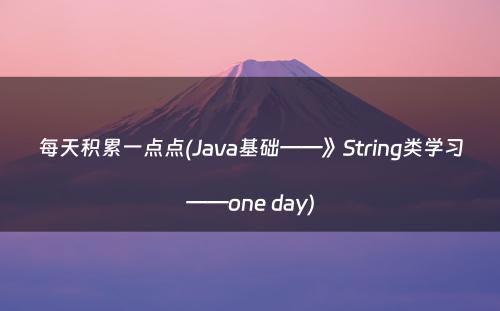网站首页 > java教程 正文
一.String类总览
1)首先我们先大致看下String类的源码

public final class String
implements java.io.Serializable, Comparable<String>, CharSequence {
/** The value is used for character storage. */
private final char value[];
/** Cache the hash code for the string */
private int hash; // Default to 0
/** use serialVersionUID from JDK 1.0.2 for interoperability */
private static final long serialVersionUID = -6849794470754667710L;
/**
* Class String is special cased within the Serialization Stream Protocol.
*
* A String instance is written into an ObjectOutputStream according to
* <a href="{@docRoot}/../platform/serialization/spec/output.html">
* Object Serialization Specification, Section 6.2, "Stream Elements"</a>
*/
private static final ObjectStreamField[] serialPersistentFields =
new ObjectStreamField[0];
.....
}
可以看出String是一个被final修饰的类,则表示该类不能被继承,其成员方法也被final修饰,
还可以看出String类内部是由char数组实现字符串的。
2)我们再来看下常用的一些方法如subString(),concat(),replace()
//字符串连接方法
public String concat(String str) {
int otherLen = str.length();
if (otherLen == 0) {
return this;
}
int len = value.length;
char buf[] = Arrays.copyOf(value, len + otherLen);
str.getChars(buf, len);
return new String(buf, true);
}
//字符串截取方法
public String substring(int beginIndex, int endIndex) {
if (beginIndex < 0) {
throw new StringIndexOutOfBoundsException(beginIndex);
}
if (endIndex > value.length) {
throw new StringIndexOutOfBoundsException(endIndex);
}
int subLen = endIndex - beginIndex;
if (subLen < 0) {
throw new StringIndexOutOfBoundsException(subLen);
}
return ((beginIndex == 0) && (endIndex == value.length)) ? this
: new String(value, beginIndex, subLen);
}
//字符串替换方法
public String replace(char oldChar, char newChar) {
if (oldChar != newChar) {
int len = value.length;
int i = -1;
char[] val = value; /* avoid getfield opcode */
while (++i < len) {
if (val[i] == oldChar) {
break;
}
}
if (i < len) {
char buf[] = new char[len];
for (int j = 0; j < i; j++) {
buf[j] = val[j];
}
while (i < len) {
char c = val[i];
buf[i] = (c == oldChar) ? newChar : c;
i++;
}
return new String(buf, true);
}
}
return this;
}
由上我们可以看出在这些操作中都是new出了新的String对象,重新生成了一个字符串对象,原始对象并没有被改变。
通过观察其所有的字符串操作方法可以得出以下结论:
String对象一旦被创建就是固定不变的了,对String对象的任何改变都不影响到原对象, 相关的任何change操作都会生成新的对象。
对String类有了一个大概地了解之后明天我准备结合Java虚拟机的相关知识来深入的学习字符串常量池。
-------------爱篮球的coder
猜你喜欢
- 2024-10-01 Java中String类字符串拼接谁的效率最低
- 2024-10-01 100个Java工具类之2:字符串之多种个性化格式处理
- 2024-10-01 Java动态加载Jar实例解析(java动态加载类框架)
- 2024-10-01 Java中如何使用正则技术提取html中的任意内容
- 2024-10-01 Java String 常用方法,涵盖全部(java string的用法)
- 2024-10-01 在Java中将String转换为char(java string转换char)
- 2024-10-01 「JavaWeb基础」文件上传和下载(修订版)
- 2024-10-01 浅谈Java中字符串的初始化及字符串操作类
- 2024-10-01 MySql字符串拆分实现split功能(字段分割转列、转行)
- 2024-10-01 Java,FreeMarker,模板引擎,通过案例代码,学懂模板引擎
欢迎 你 发表评论:
- 最近发表
- 标签列表
-
- java反编译工具 (77)
- java反射 (57)
- java接口 (61)
- java随机数 (63)
- java7下载 (59)
- java数据结构 (61)
- java 三目运算符 (65)
- java对象转map (63)
- Java继承 (69)
- java字符串替换 (60)
- 快速排序java (59)
- java并发编程 (58)
- java api文档 (60)
- centos安装java (57)
- java调用webservice接口 (61)
- java深拷贝 (61)
- 工厂模式java (59)
- java代理模式 (59)
- java.lang (57)
- java连接mysql数据库 (67)
- java重载 (68)
- java 循环语句 (66)
- java反序列化 (58)
- java时间函数 (60)
- java是值传递还是引用传递 (62)

本文暂时没有评论,来添加一个吧(●'◡'●)